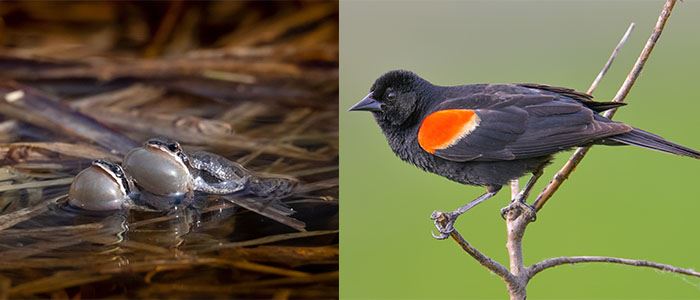Chasing Spring with Birds and Frogs

By: Kim High, Metroparks Master Interpreter
It’s officially still winter, but each year early March offers some reliable signals that spring is on its way.
Especially heart-warming to me at this time is local bird-song. Our resident songbirds who have been with us all winter long are now singing incessantly to mark their territories. Cardinals and Tufted Titmice are producing some of the most resonant, whistle-like melodies—songs that can carry significant distances and ring throughout Metroparks and neighborhoods alike. These avian vocalists might even wake you up in mornings as you wonder, “What’s the fuss?” The answer is that they are going about the important business of setting their breeding territories. Also, some of their determination in singing is likely due to the new presence of the earliest species of migratory birds returning from southerly wintering grounds.
These new arrivals from the south vie for stakes in habitat as well. Male Red-winged Blackbirds are some of the most boisterous. Recently returned to northwest Ohio for the upcoming breeding season, they fill the air with their trills and clicks while they blast over meadows and wetlands displaying the flash of red on their wings. Sometimes you can even notice the yellow on their wings when they are carrying on in this way. Here’s a fun fact: Research shows that as breeding season progresses, these ‘show-offs’ with their territorial flight antics are not the ones most likely to succeed at fathering high numbers of offspring. They are so busy exhibiting dominance that they miss the mating opportunities going on beneath them in the cattails! Also, you might be surprised to know that female Red-winged Blackbirds don’t arrive in spring until several weeks after the males, and females have completely different colors—streaked in shades of brown and buff for the sake of camouflage.
Another harbinger of spring in northwest Ohio is one of our smallest amphibians, the Western Chorus Frog. Sometimes less than an inch in length, this frog is much more likely heard than seen. In early to mid-March, if you hear something in wetlands that sounds similar to what you hear when you run your finger along the teeth of a plastic hair comb, you are hearing this little guy. The specificity of gender is intentional here, as only adult male frogs are able to sing.
Each year many local nature enthusiasts hedge bets on when they will hear their first frogs! This year, I heard my first Western Chorus Frogs singing the evening of Monday, March 8. But thanks to Metroparks Volunteers who assist with our long-term, Oak Openings Preserve Frog Survey, we have records showing that in some years, local Western Chorus Frogs start singing as early as March 1. Also very small, the Spring Peeper is a second local species known to vocalize very early in the season. Emitting staccato-like, piercing peeps, this tiny frog makes up for in noise what it lacks in size!
As our daylight increases, make it a point to get out to one of our nineteen Metroparks and see what signs of spring show up for you!